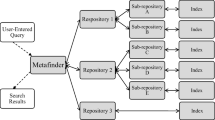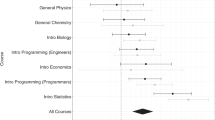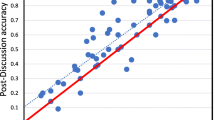Abstract
Increasing diversity in the field of behavior analysis may begin with an evaluation of culturally responsive practices in the college classroom. This study leveraged the various backgrounds of students in a university nationally recognized for diversity to evaluate the effects of peer-generated course materials on student performance in an undergraduate behavior analysis course. First, graduate students created multimedia examples (videos, pictures) of the behavioral principles in their everyday lives. Next, we curated an online bank of these examples corresponding to 4 topics (respondent conditioning, reinforcement, antecedent control, extinction and punishment) taught in an undergraduate behavior analysis course. We used a multiple-probe and between-group design to evaluate the effects of these peer-generated materials as supplements to traditional instruction. Students showed evidence of concept acquisition on all topics. However, results showed that peer-generated examples, as supplements to textbook and lectures, did not enhance students’ performance on knowledge assessments but were rated by students as more preferred, culturally responsive, and diverse than textbook examples.




Similar content being viewed by others
References
Banks, J. A. (2006). Cultural diversity and education: Foundations, curriculum and teaching. Boston: Pearson Education.
Bernstein, D., & Chase, P. N. (2013). Contributions of behavior analysis to higher education. In G. J. Madden (Ed.), APA handbook of behavior analysis (pp. 523–543). Washington, DC: American Psychological Association. https://doi.org/10.1037/13938-021.
Bottiani, J. H., Larson, K. E., Debnam, K. J., Bischoff, C. M., & Bradshaw, C. P. (2017). Promoting educators’ use of culturally responsive practices: A systematic review of inservice interventions. Journal of Teacher Education, 693(4), 67–385. https://doi.org/10.1177/0022487117722553.
Brown, M. R. (2007). Educating all students: Creating culturally responsive teachers, classrooms, and schools. Intervention in School and Clinic, 43(1), 57–62. https://doi.org/10.1177/10534512070430010801.
Carroll, R. A., & St. Peter, C. C. (2017). Proportion of available points predicts student attendance in college courses. The Psychological Record, 67(1), 61–69. https://doi.org/10.1007/s40732-016-0207-y.
Cooper, J. O., Heron, T. E., & Heward, W. L. (2006). Applied behavior analysis (2nd ed.). Upper Saddle River: Prentice Hall.
DeLeon, I. G., Bullock, C. E., & Catania, A. C. (2013). Arranging reinforcement contingencies in applied settings: Fundamentals and implications of recent basic and applied research. In G. J. Madden (Ed.), APA handbook of behavior analysis (pp. 47–75). Washington, DC: American Psychological Association. https://doi.org/10.1037/13938-021.
Fong, E. H., & Tanaka, S. (2013). Multicultural alliance of behavior analysis standards for cultural competence in behavior analysis. International Journal of Behavioral Consultation and Therapy, 8, 17–19. https://doi.org/10.1037/h0100970
Fong, E. H., Catagnus, R. M., Brodhead, M. T., Quigley, S., & Field, S. (2016). Developing the cultural awareness skills of behavior analysts. Behavior Analysis in Practice, 9, 84–94. https://doi.org/10.1007/s40617-016-0111-6.
Garcia, C., & Chun, H. (2016). Culturally responsive teaching and teacher expectations for Latino middle school students. Journal of Latina/o Psychology, 4(3), 173. https://doi.org/10.1037/lat0000061.
Gay, G. (2002). Preparing for culturally responsive teaching. Journal of Teacher Education, 53(2), 106–116. https://doi.org/10.1177/0022487102053002003.
Griner, A. C., & Stewart, M. L. (2013). Addressing the achievement gap and disproportionality through the use of culturally responsive teaching practices. Urban Education, 48(4), 585–621. https://doi.org/10.1177/0042085912456847.
Gullicks, K. A., Pearson, J. C., Child, J. T., & Schwab, C. R. (2005). Diversity and power in public speaking textbooks. Communication Quarterly, 53(2), 247–258. https://doi.org/10.1080/01463370500089870.
Ladson-Billings, G. (1995). Toward a theory of culturally relevant pedagogy. American Educational Research Journal, 32(3), 465–491. https://doi.org/10.3102/00028312032003465.
Malott, R., & Shane, J. T. (2015). Principles of behavior. New York: Psychology Press.
Marmolejo, E. K., Wilder, D. A., & Bradley, L. (2004). A preliminary analysis of the effects of response cards on student performance and participation in an upper division university course. Journal of Applied Behavior Analysis, 37, 405–410. https://doi.org/10.1901/jaba.2004.37-405.
McIlvane, W. J. (2013). Simple and complex discrimination learning. In G. J. Madden (Ed.), APA handbook of behavior analysis (pp. 129–163). Washington, DC: American Psychological Association. https://doi.org/10.1037/13938-021.
Miller, L. K. (2005). Principles of everyday behavior analysis. Monterey: Brooks/Cole Publishing.
Miller, L. K., & Weaver, F. H. (1976). A behavioral technology for producing concept formation in university students. Journal of Applied Behavior Analysis, 9, 289–300. https://doi.org/10.1901/jaba.1976.9-289.
Miltenberger, R. G. (2011). Behavior modification: Principles and procedures. Belmont, CA: Wadsworth, Cengage Learning.
Neef, N. A., McCord, B. E., & Ferreri, S. J. (2006). Effects of guided notes versus completed notes during lectures on college students’ quiz performance. Journal of Applied Behavior Analysis, 39, 123–130. https://doi.org/10.1901/jaba.2006.94-04.
Perrin, C. J., Miller, N., Haberlin, A. T., Ivy, J. W., Meindl, J. N., & Neef, N. A. (2011). Measuring and reducing college students’ procrastination. Journal of Applied Behavior Analysis, 44, 463–474. https://doi.org/10.1901/jaba.2011.44-463.
Rodriguez, M. C. (2005). Three options are optimal for multiple‐choice items: a meta‐analysis of 80 years of research. Educational Measurement: Issues and Practice, 24(2), 3–13. https://doi.org/10.1111/j.1745-3992.2005.00006.x.
Rehfeldt, R. A., Walker, B., Garcia, Y., Lovett, S., & Filipiak, S. (2010). A point contingency for homework submission in the graduate school classroom. Journal of Applied Behavior Analysis, 43, 499–502. https://doi.org/10.1901/jaba.2010.43-499.
Sampson, D., & Garrison-Wade, D. F. (2011). Cultural vibrancy: Exploring the preferences of African American children toward culturally relevant and non-culturally relevant lessons. The Urban Review, 43(2), 279–309. https://doi.org/10.1007/s11256-010-0170-x.
Shimamune, S., & Malott, R. W. (1994). An analysis of concept learning: Simple conceptual control and definition-based conceptual control. The Analysis of Verbal Behavior, 12, 67–78. https://doi.org/10.1007/BF03392898.
Walker, B. D., Rehfeldt, R. A., & Ninness, C. (2010). Using the stimulus equivalence paradigm to teach course material in an undergraduate rehabilitation course. Journal of Applied Behavior Analysis, 43, 615–633. https://doi.org/10.1901/jaba.2010.43-615.
Acknowledgements
We thank the California State University, Northridge, Master of Science in Applied Behavior Analysis students for their vast contributions to the completion of this study. We thank Emily Tierman, Jasmine Poetry, Elizabeth Hernandez, and Carissa Basile for their help with this study.
Funding
This research was supported in part by NIGMS BUILD (Building Infrastructure Leading to Diversity) grants TL4GM118977 and RL5GM118975.
Author information
Authors and Affiliations
Corresponding author
Ethics declarations
Ethical Approval
All procedures performed in studies involving human participants were in accordance with the ethical standards of the institutional and/or national research committee and with the 1964 Helsinki declaration and its later amendments or comparable ethical standards.
Informed consent
Informed consent was obtained from all individual participants included in the study.
Additional information
Publisher’s Note
Springer Nature remains neutral with regard to jurisdictional claims in published maps and institutional affiliations.
Research Highlights
• Designing instruction for an increasingly diverse student body is of great relevance to the cultivation of diversity in the field of behavior analysis.
• Current technologies easily enable students to generate and share in-the-moment examples of the principles of behavior analysis in their everyday lives.
• Peer-generated content can supplement traditional college textbooks to increase the cultural responsiveness of teaching practices.
• Students performed similarly on tests of knowledge whether or not they had access to peer-generated examples as supplements to textbook chapters and lectures.
• Students rated peer-generated examples of behavioral concepts as more preferred, diverse, and culturally responsive compared to traditional textbook examples.
Appendices
Appendix A
A collection of peer-generated examples, shared with permission by Uilani Elmer, Alejandra Chiu, Michael Aragon, and Neomi Garzon. Example of the behavioral jargon description of the top left example, above: I complained (highly aversive auditory stimulus) very much about the sun in my face one day until he stuck this piece of cardboard on the visor. Then my complaining suddenly stopped. Now when the sun is bright and I'm in the car, he sticks this up and avoids my complaining (negative reinforcement)
Appendix B
Rights and permissions
About this article
Cite this article
Nava, C.E., Fahmie, T.A., Jin, S. et al. Evaluating the Efficacy, Preference, and Cultural Responsiveness of Student-Generated Content in an Undergraduate Behavioral Course. Behav Analysis Practice 12, 747–757 (2019). https://doi.org/10.1007/s40617-019-00344-7
Published:
Issue Date:
DOI: https://doi.org/10.1007/s40617-019-00344-7








